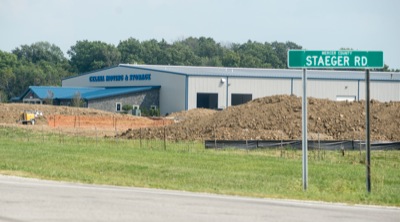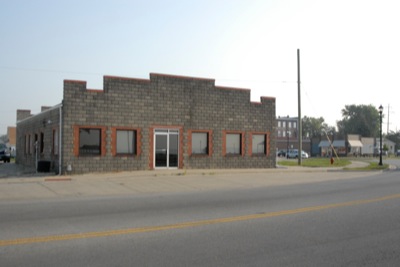Thursday, September 3rd, 2015
Work begins on Celina's new 1M gallon water tower
By William Kincaid

Photo by Mark Pummell/The Daily Standard
Employees from Landmark Structures of Fort Worth, Texas, remove earth in Celina's Grand Lake Industrial Park in preparation of erecting a 1-million gallon water tower.
CELINA - Work has begun on a multimillion-dollar water tower in the Grand Lake Industrial Park.
Landmark Structures recently began removing earth and pouring concrete for the base of the structure. However, the 1-million-gallon water tower will not be finished until October 2016, mayor Jeff Hazel told the newspaper on Wednesday.
The city's board of controls recently awarded a $2.27 million contract to Landmark to erect the tower and a $15,760 contract to Iseler Demolition Inc. to raze the 250,000-gallon tower on Grand Lake Road.
The new tower will replace the aging Grand Lake Road tower, which serves all of Celina's industrial and retail areas near Havemann Road as well as homes and other properties near state Route 703 to the Wright State University-Lake Campus in Jefferson Township.
When coupled with the 1.5-million gallon water tower on Summit Street, built for $1.8 million in 2005, the new tower will greatly enhance water volume and pressure, according to Hazel.
"The new tank also will ... provide adequate water for fire protection and periods of service interruption and provide capacity to meet future increases in water demand," an Ohio Environmental Protection Agency press release states.
Celina will own the tower. Mercer County officials in 1962 agreed to have the current tower constructed as part of an East Jefferson Township water system. The city, under contract, has maintained the system for the county since then.
The city is financing the project with a $1 million zero-interest OEPA loan, which will be paid back over 20 years. All other funds, including repayment of the loan, will come from the water account and the Staeger Road Tax Increment Financing District, which has a balance of about $1 million, according to Hazel.
TIF revenue comes from taxes on any increase in land or building values in each district after establishment of the TIF, an economic development mechanism available to local governments. TIF districts allow for real estate taxes on new development to be diverted into separate accounts to be used for public infrastructure projects within the district. TIFs can run for 25 years.
Also, by utilizing the loan, the city will maintain a reserve in the TIF in case it must improve streets within the TIF district, which includes Walmart and Menards, according to Hazel. City debt from the Johnson Avenue, Grand Lake Road and Buckeye Street projects is also being paid back from Staeger Road TIF funds.
OEPA offered $50 million in zero-interest loans to drinking water plants for upgrades and back-up water sources to combat the effects of harmful algal blooms. Preference was given to systems in the Lake Erie watershed and those that had experienced harmful algal blooms, thus qualifying Celina for the financing, according to OEPA.






